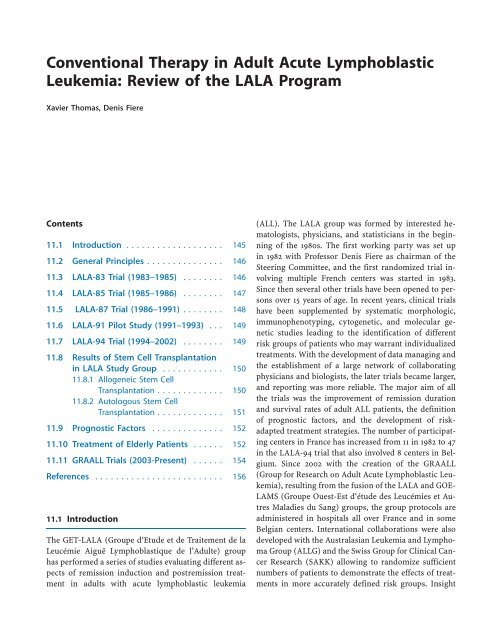Acute Leukemias - Republican Scientific Medical Library
Acute Leukemias - Republican Scientific Medical Library
Acute Leukemias - Republican Scientific Medical Library
Create successful ePaper yourself
Turn your PDF publications into a flip-book with our unique Google optimized e-Paper software.
Conventional Therapy in Adult <strong>Acute</strong> Lymphoblastic<br />
Leukemia: Review of the LALA Program<br />
Xavier Thomas, Denis Fiere<br />
Contents<br />
11.1 Introduction ................... 145<br />
11.2 General Principles ............... 146<br />
11.3 LALA-83 Trial (1983–1985) ........ 146<br />
11.4 LALA-85 Trial (1985–1986) ........ 147<br />
11.5 LALA-87 Trial (1986–1991) ........ 148<br />
11.6 LALA-91 Pilot Study (1991–1993) ... 149<br />
11.7 LALA-94 Trial (1994–2002) ........ 149<br />
11.8 Results of Stem Cell Transplantation<br />
in LALA Study Group ............ 150<br />
11.8.1 Allogeneic Stem Cell<br />
Transplantation ............. 150<br />
11.8.2 Autologous Stem Cell<br />
Transplantation ............. 151<br />
11.9 Prognostic Factors .............. 152<br />
11.10 Treatment of Elderly Patients ...... 152<br />
11.11 GRAALL Trials (2003-Present) ...... 154<br />
References ......................... 156<br />
11.1 Introduction<br />
The GET-LALA (Groupe d‘Etude et de Traitement de la<br />
Leucémie Aiguë Lymphoblastique de l’Adulte) group<br />
has performed a series of studies evaluating different aspects<br />
of remission induction and postremission treatment<br />
in adults with acute lymphoblastic leukemia<br />
(ALL). The LALA group was formed by interested hematologists,<br />
physicians, and statisticians in the beginning<br />
of the 1980s. The first working party was set up<br />
in 1982 with Professor Denis Fiere as chairman of the<br />
Steering Committee, and the first randomized trial involving<br />
multiple French centers was started in 1983.<br />
Since then several other trials have been opened to persons<br />
over 15 years of age. In recent years, clinical trials<br />
have been supplemented by systematic morphologic,<br />
immunophenotyping, cytogenetic, and molecular genetic<br />
studies leading to the identification of different<br />
risk groups of patients who may warrant individualized<br />
treatments. With the development of data managing and<br />
the establishment of a large network of collaborating<br />
physicians and biologists, the later trials became larger,<br />
and reporting was more reliable. The major aim of all<br />
the trials was the improvement of remission duration<br />
and survival rates of adult ALL patients, the definition<br />
of prognostic factors, and the development of riskadapted<br />
treatment strategies. The number of participating<br />
centers in France has increased from 11 in 1982 to 47<br />
in the LALA-94 trial that also involved 8 centers in Belgium.<br />
Since 2002 with the creation of the GRAALL<br />
(Group for Research on Adult <strong>Acute</strong> Lymphoblastic Leukemia),<br />
resulting from the fusion of the LALA and GOE-<br />
LAMS (Groupe Ouest-Est d‘étude des Leucémies et Autres<br />
Maladies du Sang) groups, the group protocols are<br />
administered in hospitals all over France and in some<br />
Belgian centers. International collaborations were also<br />
developed with the Australasian Leukemia and Lymphoma<br />
Group (ALLG) and the Swiss Group for Clinical Cancer<br />
Research (SAKK) allowing to randomize sufficient<br />
numbers of patients to demonstrate the effects of treatments<br />
in more accurately defined risk groups. Insight
















